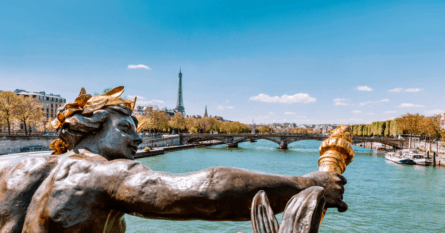You’ll often hear someone describe a well-designed vehicle as “a piece of art”, but what about when it actually is a piece of art (or at least part of one)? Here is a selection of the most iconic works of art featuring cars, and why they deserve that title.

“Cars”
Andy Warhol
It’s no surprise that the king of consumerist art (or maybe it’s artistic consumerism) loved cars, even though he didn’t drive. It turns out, cars loved him right back, or at least Mercedes-Benz did. In 1986 they commissioned Warhol to create a series of paintings, silk screens, and drawings on the evolution of their vehicles. In his lifetime, Warhol completed 49 of the 80 planned pop art pieces. Most of the works were reproduced from photographs and were done in trademark Warhol style. The series has been exhibited to the public only a few times since Warhol’s death in 1987, and only exhibited in full in 1988, 2010, and 2014. The series is now in Daimler’s Art Collection.
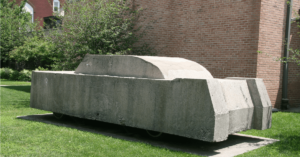
“Concrete Traffic”
Wolf Vostell
Described by Vostell as an “instant happening”, the process of encasing this Cadillac in concrete was just as much a part of the art as the final product. Commissioned by the Chicago Museum of Contemporary Art in 1970, the piece was assembled in a public parking lot and wasn’t moved until a few months later when the parking tickets started adding up. It was later donated to the University of Chicago, and today sits in the university’s main parking garage. Concrete Traffic is both about concrete as a symbol for traffic congestion and an exploration of how the material can be used as an artistic medium.

“Trabi”
Birgit Kinder
“Trabi” may not have been painted that long ago with the first iteration in 1990, but it is already entrenched in history. In a perfect marriage of artistic message and canvas, Kinder’s painting of a Trabant breaking through the Berlin Wall (painted on a remaining section of the Wall) is one of the most easily recognizable works of the East Side Gallery. While being a depiction of the destruction of the wall and (literal) drive toward unification, it also comments on the means of production, the Trabant being exclusively produced in East Germany. The public mural is a must-see for any visitor in Berlin.
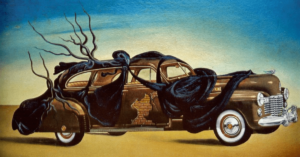
“Clothed Automobiles”, “Rainy Taxi” (a.k.a “Mannequin Rotting in a Taxi-Cab”), and many more
Salvador Dali
Another artist who rarely drove, Dali included vehicles in several of his paintings, collages, and installation pieces. In his “Clothed Automobiles” collages, he dresses Cadillacs in fine fabrics. For “Rainy Taxi” he posed two mannequins in a car with lettuce, chicory, and snails, but that’s not all. He also set up a series of pipes make it rain inside the vehicle, and put a full-size bronze statue in the place of a hood ornament. To get to the Sorbonne to give a lecture titled “Phenomenological Aspects of the Paranoiac Critical Method”, Dali borrowed a friend’s Rolls Royce, which he filled entirely with cauliflower. The Thompson Twins even came out with a song called Salvador Dali’s Car. While trying to truly unearth the deeper meaning behind any of Dali’s work may be a fool’s errand, he has made it clear that to him the car is a symbol of modernization and progress.

Art cars
Various artists
It’s impossible to pick just one art car or even just one particular artist because there have been so many. Whether it’s just an enthusiast with great decorative ability, or a recognized artistic legend like Andy Warhol or Roy Lichtenstein, cars have been used as canvases tracing back to 1925. That was when Sonia Delaunay painted a car to mimic the pattern of some fur coats she had designed. Art cars gained more legitimacy in 1975, when BMW started commissioning various famous artists to put their own stamp of creativity on BMW vehicles. Art cars are very tactile explorations of the intersection of commercialism and art. They also made so-called “high art” more accessible, by applying it to an object used in everyday life. The most recent BMW art car, done last year by Chinese contemporary artist Cao Fei, even incorporates virtual reality, so we can’t wait to see what comes next.
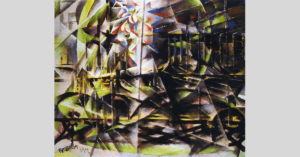
“Speeding automobile” and many more
Giacomo Balla
Inspired by the founder of Futurism, Filippo Tommaso Marinetti, Giacomo saw the car as the pinnacle of modernity. When he began painting in the late 1880s, Balla’s paintings were typical of the time, but by 1910 he had found his calling in abstract art. He was less interested in capturing what cars actually look like, and more interested in trying to visually represent their movement. This was evident in paintings like “Ritmo + rumore + velocità d’automobile” (Rhythm + noise + car speed) and “Velocity of Cars and Light”. Ironically, Balla’s Futurist art is now seen as a window into the past. The Futurist movement was closely tied to the Italian Fascist Party. The movement’s founder (the aforementioned Marinetti) was actually one of the party’s first members. While Mussolini didn’t care much for art (unless as a tool for propaganda), he recognized that it was a point of pride for Italian people, and knew that it was important to his Futurist supporters like Balla. What he probably didn’t anticipate was its eventual value to art historians.
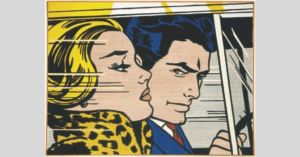
“In the car”
Roy Lichtenstein
Lichtenstein’s BMW art car wasn’t his only work involving an automobile. In this 1963 painting, the car is secondary, a frame confining the emotions of its passengers into a small space. In his classic cartoonish style, Lichtenstein reproduced a panel from the comic “Girls’ Romances” published two years before. He omitted the caption from the original comic: “I vowed to myself I would not miss my appointment— That I would not go riding with him— Yet before I knew it…”. Lichtenstein preferred to let the passengers’ expressions speak for themselves, a choice that gave the painting the appeal of ambiguity. In 2005, “In the car” was sold for $16.2 million, the biggest price tag any of his paintings had had to date. While it’s now been eclipsed by his most meta work “Masterpiece” (which sold for $165 million last year), it’s still considered one of Lichtenstein’s most iconic and recognizable paintings.
Which one is your favorite? Let us know on social media.
